In various contexts, Joseph Beuys reflected on numerous aspects of Friedrich Nietzsche’s philosophy and their influence on his work, ranging from his dissociation from dogmatic Christianity through to his sympathy for the nomadic and the concepts of the Apollonian and the Dionysian. This paper will highlight one principal aspect of Nietzsche’s writings – the concepts of the ‘Great Reason of the Body’ and the ‘Guideline of the Body’1 – and will attempt to show how Beuys understood them from the early 1940s onwards. His interpretative comments are then related to various literal and artistic statements the artist made throughout his career.
When investigating the possible influence of the writings of Nietzsche on Beuys, some methodological aspects and problems should be named in advance in order to avoid misunderstandings and false expectations. First of all, the two were not contemporaries. Any influence of Nietzsche on Beuys, therefore, could only take place through Beuys’s reception of Nietzsche’s writings. It should be noted, however, that only twenty-one years separate Nietzsche’s death in 1900 and Beuys’s birth in 1921. Of course, more indirect influences of Nietzsche on Beuys will exist via the mediation of other artists or authors. These, however, are not the focus of this present article.2 Furthermore, since Beuys did not write essays reflecting on Nietzsche, the analysis of Beuys’s reception can only be based on individual comments, remarks and explanations given in interviews, and keywords that may be found throughout his work or in his library and written documents from the 1940s to the 1980s. The key testimonies for the intellectual and aesthetic influence of Nietzsche on Beuys fall into the latter category: Beuys’s commentaries, written around 1941, in his edition of Nietzsche’s later writings, which are archived in the Joseph Beuys Estate Düsseldorf, Germany. These commentaries were made accessible for the first time in my 2016 book, Joseph Beuys liest Friedrich Nietzsche: Das autopoietische Subjekt: Von der Artistenmetaphysik zur Freiheitswissenschaft (Joseph Beuys’s Reading of Friedrich Nietzsche: The Autopoietic Subject: From Artist Metaphysics to Freedom Science).3
It is worth bearing in mind that in his work, Beuys never illustrates Nietzsche’s work in a plain and figurative manner, but creatively adopts and transforms basic epistemological insights of Nietzsche, such as perspectivism.4 Beuys’s creative processing of his interpretation of the ideas and concepts in Nietzsche’s writings is naturally broken down in a variety of ways; in addition, there are numerous other intellectual and aesthetic influences and interactions at play in the artist’s thought. With this in mind, a simple causal analysis is virtually impossible.
Finally, it is important to note that the interpretative approach and focus of this paper is not meant to be reductive and that I am fully aware of many other sources that influenced Beuys’s work. However, it can be argued that Nietzsche’s philosophy is one of the most important influences for Beuys, demonstrated by the similarity of their core ideas and pragmatic concepts. While Beuys’s thinking and artworks should not be reduced solely to Nietzschean philosophy, a thorough reading of important texts by Nietzsche is indispensable for understanding Beuys’s conceptions of human epistemological limitations and creative potentials.
‘The Guideline of the Body’
In Thus Spoke Zarathustra (1883–91), Nietzsche wrote:
But greater is that in which you do not wish to believe – our body with its great intelligence; it does not say ‘I’, but does ‘I’. What the sense feels, what the spirit knows, never has its end in itself. But sense and spirit would persuade you that they are the end of all things: that is how vain they are. Instruments and toys are sense and spirit: behind them there is still the self. The self also seeks with the eyes of the senses, it also listens with the ears of the spirit. Always the self listens and seeks; it compares, overpowers, conquers, and destroys. It rules, and is also the ruler of the ‘I’. Behind your thoughts and feelings, my brother, stands a mighty ruler, an unknown sage – it is called the subconscious self; it dwells in your body, it is your body.5
Throughout his work, Nietzsche’s rather unsystematic use of the notion of the body relies on implicit definitions. All in all, the usage of the term ‘body’ seems to be Nietzsche’s metaphorical way of grasping the ‘self’, mainly as the ‘subconscious self’, thereby avoiding the notion of the soul in the sense of a simple, basic substance. Rather, Nietzsche mostly conceives the (human) body as an aggregate of physio-psychological forces – of will, instincts and emotions. In doing so, he built on the physio-psychology which emerged in the second half of the nineteenth century and, together with Arthur Schopenhauer, turned away from the body-soul dualisms of scholasticism and transcendental philosophy. In accordance with this, for Beuys, thinking, speaking, acting and forming the social organism are sculptural processes, realisations of a will for (self-)formation. This ambition culminates in his formulation, ‘Man himself becomes the creator of the world and experiences how he can continue creation. That is also his entire responsibility.’6 Consequently, for him, the human body as the physiological basis of the will and self is also a kind of sculpture, which is formed through the physiological and psychological growth and development of a person.
In his drawings and performances Beuys shows the body being moulded by life and illness; he demonstrates the exercising of self-control, the will to grow, the accumulation of energy and the body’s vulnerability. At the core of Beuys’s understanding is the epistemological conviction that the corporeal body is the basis for the perception of the world and the proactive self-formation of individual and society.
Nietzsche was not only a pioneer of the theory of performance art but also of the concept of embodied thinking.7 He developed the idea of the ‘Great Reason of the Body’ and announced that the genealogy of his philosophy developed under the ‘Guideline of the Body’. He regarded the idea of a body-independent soul or spirit as a philosophical, religious and moral-theological error. Accordingly, in a fragment from the summer of 1880, Nietzsche wrote: ‘I have always written my writings with all my body and life: I do not know what “purely spiritual” problems are’.8 Furthermore, in fragments he produced between the summer and autumn of 1884 referring to the genealogy of his philosophy, he confessed: ‘I estimate everything to be unfruitful which arises from self-adulation of the spirit and … I do not believe in good research without the guideline of the body’.9 In a metaphorical description of the anatomy of his writings, Nietzsche reflects this principle of embodiment in the poem ‘Writing with One’s Feet’ in The Gay Science (Fröhliche Wissenschaft):
Not with my hand alone I write:
My foot wants to participate.
Firm and free and bold, my feet
Run across the field – and sheet.10
In paragraph thirty-four of the Twilight of the Idols, in reaction to writer Gustave Flaubert’s assertion that thinking and writing is only possible while sitting, Nietzsche states:
On ne peut penser et écrire qu’assis (Gustave Flaubert).— Now I’ve got you, you nihilist! Assiduity is the sin against the Holy Spirit. Only thoughts that come by walking have any value.11
This paragraph was marked by Beuys with a fine pencil line, probably an exclamation mark with a slightly slipped dot. Beuys read especially the late works of Nietzsche, though not only these – his reading of Nietzsche extended from his school years to at least his early twenties. He made about 200 annotations in his edition of Nietzsche’s late works, which he probably bought in 1941.12 The works Beuys studied intensively are The Case of Wagner (1888), Nietzsche contra Wagner (1889), Ecce Homo (1908), Twilight of the Idols (1889), Anti-Christ (1895) and Nietzsche’s poems.13
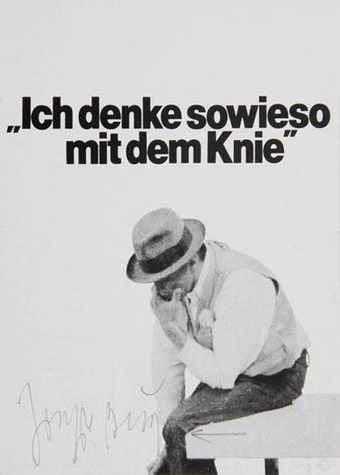
Fig.1
Joseph Beuys
Ich denke sowieso mit dem Knie 1977
© DACS 2019
The above-mentioned paragraphs from The Gay Science and Twilight of the Idols are a starting point for my exploration of the relationship between Nietzsche and Beuys, concerning as they do the art of performance and an ‘expanded concept of art’ (Erweiterter Kunstbegriff). These citations signal Nietzsche’s nomadic and performative thinking, to which Beuys was explicitly sympathetic. They articulate the possibility of thinking in psycho-physical dynamics, thinking with and through the body, which mobilises the whole being. Beuys put his own pointed expression of corporeal thinking in a succinct and yet startling synthesis of text and image in his 1977 postcard multiple Ich denke sowieso mit dem Knie (I Think Anyway with the Knee) (fig.1).14 Like Nietzsche, in this spirit Beuys argues for a concept of an ‘embodied mind’ or even ‘extended mind’, while both declare embodiment as a necessity of their performative philosophy, artistic life and everyday practice. This seems already to indicate that Beuys has engaged intensively with Nietzsche’s epistemology. Indeed, this is evidenced not only by Beuys’s annotations to Nietzsche’s writings and by Beuys’s own works, but also by many remarks that attest to this interest, such as his dictum: ‘So, why is everyone so busy with Duchamp? Why is it that no one has thought a bit longer about Schiller and Nietzsche?’15
For Nietzsche, even a paradigm of his aesthetics is literally based on a body metaphor – in The Case of Wagner (1888), he writes: ‘“All that is good is easy, everything divine runs with light feet”: this is the first principle of my aesthetics.’16 This text passage was also marked in Beuys’s edition with a question mark and a large ‘N’ written over it, which seems to negate Nietzsche’s thought – perhaps in a second step of reflection. This negation perfectly reflects Beuys’s aesthetics: almost nothing in his work is running on ‘light feet’ – it is mostly not about what is divine, but about what is human. His work focuses on hurt, weighted, disabled or isolated feet, shown for example in the action Wie man dem toten Hasen die Bilder erklärt (How to Explain Pictures to a Dead Hare) 1965; or in Eurasienstab (Eurasian Staff) 1967, in which Beuys performed with an iron sole strapped under his right foot while climbing up to work fat into one of the room’s upper corners.
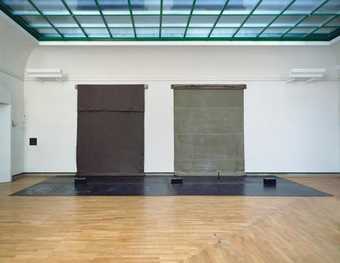
Fig.2
Joseph Beuys
Plastischer Fuß, elastischer Fuß 1969
Staatsgalerie, Stuttgart
© DACS 2019
The fat corner is a moulded triangular shape associated with the Christian symbol of the divine trinity. If one further interprets this association, then Beuys’s action in this context describes the formation of a concept of God by the ascending, self-exalting man. The large installation Plastischer Fuß, elastischer Fuß (Plastic Foot, Elastic Foot) 1969 (fig.2) in the Staatsgalerie Stuttgart, Germany, is a metaphor for the complimentary principles of possible sculptural performances: the plastic and elastic method of working with a soft material. Two tarpaulin-like objects – one made of rubber, the other felt – are installed on the wall and touch down to the floor in a thick, heavy bulge, which stands for the feet mentioned in the title of the work. Beuys’s commitment to the earthly, the motive of being rooted in the earth, of all kinds of ‘base camps’ (Basislager) is evidenced by these installations. Planet earth is the basis for human life and therefore for spirituality, which in Beuys’s view is probably not limited to man. He repeatedly reformulated this conviction: human spirituality is transformed out of matter; metaphorically it is rooted in matter like plants are rooted in the earth. Beuys’s aesthetic is not lightweight and ‘divine’, but based on the human, the earthly and matter. In an interview with Horst Kurnitzky and Jeannot Simmen, Beuys explains how important matter is for him. He believes:
that all the decisive questions of the world, man and spirit are contained in matter. I am not a materialist in the sense of materialism which has dealt with matter in such a bad way that it has tormented, made it sick, brought it to extinction. I am a materialist in the sense that I say: I want to live with matter, think, etc. ... Yes, I would like to be a better materialist or have a materialism that really takes matter seriously, comes into dialogue with it and does not just talk about the exploitable dimension of matter.17
As mentioned above, it is the principle of the ‘Guideline of the Body’ which designates Nietzsche as the forefather of the ‘performative turn’, to use theatre studies academic Erika Fischer-Lichte’s phrase.18
In addition to this, two further principal arguments underline Nietzsche’s influence on performance. The first concerns the philosopher being not just an initiator of a philosophy of the body, but also a philosophy of life: ‘The product of the philosopher is his life (first, before his works). That’s his work of art.’19 Correspondingly, for Beuys, his performances and also any form of consciously exerted human labour are action fields of creative formation and self-formation. He speaks of his performances in these terms:
I myself am the artwork at this moment. That is, it is yet to come that man itself is the work of art ... And that potentially every human can participate in this realisation, to make the world a work of art (as social sculpture).20
The second further argument is as follows: Nietzsche is a pioneer of performance because his philosophy is staged, fluid, narrative, rhetorical, sensual, aphoristic, style-conscious and anti-systematic; it is open to interpretation with plenty of ambiguities and sometimes contradictions; it is basically unfinished, and invites the reader or listener to work with it and transform it.21 What the philosopher Werner Stegmaier calls Nietzsche's philosophy of ‘fluidity’ (Fluktuanz) originates not least from his estimation of Heraclitus, an affinity which is also shared by Beuys.22 In his own edition of Twilight of the Idols Beuys marked a long passage dealing with Heraclitus in the section ‘The “Reason” in Philosophy’. Heraclitus also rejected the senses, says Nietzsche, like other philosophers did, but not because the senses showed multiplicity and change, but because they showed things as if they had permanence and unity: ‘”Reason” is the reason we falsify the testimony of the senses. Insofar as the senses show becoming, passing away, and change, they do not lie … The “apparent” world is the only one: the “true” world is merely added by a lie.’23 Beuys came across this description of the relationship between the senses, reason and the world of ideas or truth as a young man, when it would obviously affect his basic epistemological assumptions. In an interview with Rainer Rappmann, Beuys explains his perspective on Heraclitus:
‘War is the father of all things’ by Heraclitus, this is the concept of Mars. But Heraclitus did not mean that we should shoot at each other or drop nuclear bombs. He meant that the controversy, the apparently active conflict between principles, between evolutionary principles, develops the world. So, ‘War is the father of all things’ by Heraclitus stresses this Mars element, but initially within the ideas and the concepts. So, actually he means thinking, and thinking is not without struggle. So those who are lazy thinkers will make the biggest nonsense.24
He continues, saying that he interprets this principle as an ‘eternal confrontation between the forces, which must become polarized again, which must re-harmonize themselves from the polarization, must diverge again from the harmonization at another level, because the development goes on’.25 Beuys’s political and educational commitment, his candidacy for the Green Party, actions like the boxing match for direct democracy and the commitment to the unrestricted admission of students to the Academy, all show him to be a quarrelsome intellectual. Heraclitic thinking, of course, is also expressed in the liquefaction of form through the use of grease and wax – for example in Unschlitt – Tallow 1977, an installation consisting of twenty tons of animal fat; or a work with living material such as 7000 Eichen (7000 Oak Trees) 1982, a social sculpture project where 7000 trees were planted in the German city of Kassel. Fluidity must also be extended to intellectual processes. Beuys agrees with Nietzsche that interpretations and readings are and must be changeable and unfinished: Nietzsche writes in On the Genealogy of Morality (1887): ‘The form is fluid, but the meaning is even more so.’26
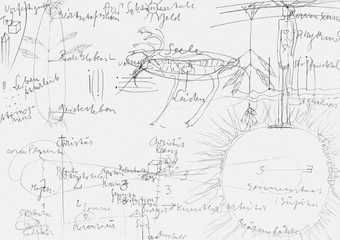
Fig.3
Joseph Beuys
Evolution 1974
© VG Bild, 2019
As Beuys started as a figurative artist, it seems far from astonishing that the body is a guideline for his work. Drawings of the body constantly figure as the basis of his diagrammatic explanations of the theory of the sculptural process or societal dynamics. A typical example is Evolution 1974 (fig.3), which combines figurative elements with symbols, icons and writing. Throughout his work Beuys utilises the human body and its parts and energies by drawing analogies between these and the variety of sculptural processes. Based on the body, Beuys simultaneously develops and visualises the connections between the overlapping and interlocking models of sculptural shaping and social transformation. In other words, in Beuys’s work his understanding of the body comprises the following categorical systems: historical genealogies; phase diagrams for the development of sculpture; the representation of different spheres of the social organism; symbols of birth and death; signs of the organic and inorganic; and references to the history of ideas. These diagrammatical drawings are documents of performative settings, staging communicative acts (such as Beuys’s activities at Documenta or on his lecture journeys); they are the interaction between discussion partners. These drawings accompany and finally show the making of thoughts during conversation and the fabrication of symbols, signs and forms while drawing. Therefore, these works perform the unity of the drawing body and conceptual thinking with signs, lines, geometric abbreviations or abstractions, movement and language. All of these are not the outcome of intimate, private, monological work, but parts of an encounter with the conversation partner.
The physiological body, by its parts and relics, appears in Beuys’s work as shaped and shaping, as exposed to forces and exerting them, in its growth and vulnerability: hair, fingernails, teeth or footprints, bones appear as real objects in installations and showcases like Vitrine 1958/1972 (Staatsgalerie Stuttgart). Throughout his work Beuys isolates or focuses parts of the body in a downright encyclopaedic breadth, in any conceivable perspective and attitude – blood and nerves, liver, heart, kidney and gastrointestinal forms, circulation systems, the larynx and the lungs, hands, fingers, feet, the vocal cords, eye or ear and so far and so forth. One has merely to read a list of titles of early works – derived from his exhibition Stallausstellung – Fluxus 1963 in Kranenburg – to come to know the wide range of physical and anatomical subjects Beuys covers in his works: Hand (Hand), Damenschädel sieht Décollage (Lady’s Skull sees Décollage), Gehirnmasse und Rock (Brain Mass and Skirt), Pulsschlag (Pulse), Blut durch Nerven zerstört (Blood Destroyed by Nerves), Blut und Nerv (Blood and Nerve), Ohrenmensch mit Projektor (Ears-Person with Projector), Der große Bärenvulkan (Denkmal für eine Milz) (The Great Bear Volcano [Monument to a Spleen]), Die Zähne XL (Teeth XL), Schädel des Königskindes (Skull of the Royal Child).27
After recovering from a heart attack, Beuys made an electrocardiogram of his own heartbeat an element of a work with the ambiguous title notfalls leben wir auch ohne Herz (If Necessary, We Live Without a Heart). What Beuys playfully expresses here – connected to the revolutionary thinker and aristocrat Anacharsis Cloots, whose writings were part of this work – can partially be connected to Nietzsche’s concept of the ‘pathos of distance’.28 In Beyond Good and Evil, Nietzsche defines ‘the pathos of distance’ as the ‘longing for an ever new widening of distances inside the soul itself, the development of even higher, rarer, more distant, more expansive, more comprehensive states, in short, simply the enhancement in the type “man”, the constant “self-conquest of man”’.29 In his performative use of his own body, Beuys was able to overcome himself and his deficiencies by looking at his fate and weakness from a distance, in a form of ‘self-overcoming’.
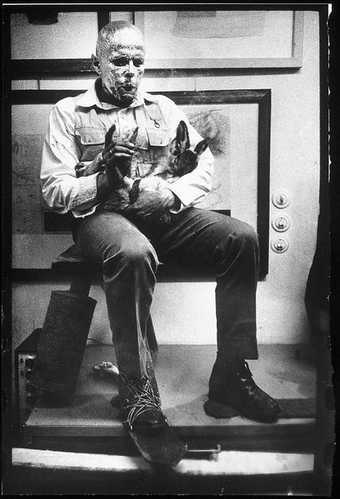
Fig.4
Ute Klophaus
Joseph Beuys performing How to Explain Pictures to a Dead Hare 1965
© Ute Klophaus
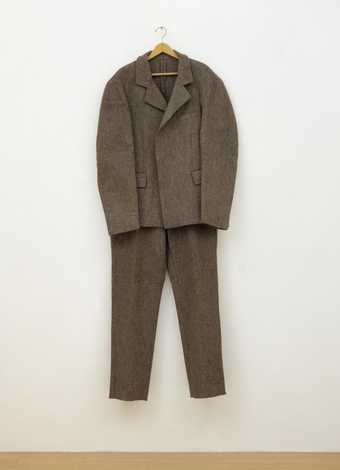
Fig.5
Joseph Beuys
Felt Suit 1970
Tate T07441
© DACS 2019
In Beuys’s performances, the whole body is usually involved and its various parts given special focus: he coats his head with gold leaf in How to Explain Pictures to a Dead Hare 1965 (fig.4); he covers his lower abdomen in Hauptstrom (Main Current) 1967; he uses his teeth to form imprints.30 In addition, the body, which is made invisible or is absent, stays dialectically present – such as in Lichamen (Bodies) 1967, The Chief 1964, Voglio vedere le mie montagne (I Want to See My Mountains) 1950–71 or Show Your Wound 1977. Showing the wound literally means showing the body in all its weakness, vulnerability and biological constitution; it also provides a possible symbol for resurrection through the allusion to Christ showing his wound to Thomas as proof of his identity and divinity. Textile sculptures like Felt Suit 1970 (fig.5) also show the body through highlighting its disappearance or absence. This again shows that the body remains the guideline for his art even when works are not visually figurative.
The Great Reason of the Body
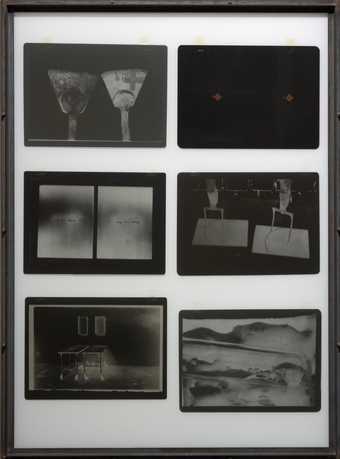
Fig.6
Joseph Beuys
Show Your Wound 1977
Tate T07976
© DACS 2019
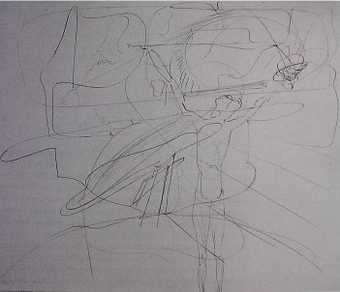
Fig.7
Joseph Beuys
Zarathustra 1954
Museum Schloss Moyland, Bedburg-Hau
© DACS 2019
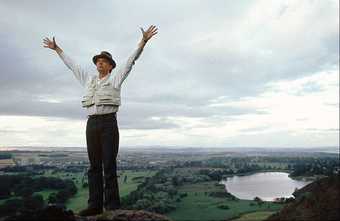
Fig.8
Robert Lebeck
Joseph Beuys on Arthur’s Seat, Edinburgh 1974
© Robert Lebeck, with permission of Cordula Lebeck
Show Your Wound 1977 (fig.6) and the works derived from it appeal to the viewer to act as a performer – namely to stage their own corporeality, illness or trauma. Nietzsche and Beuys both understood wounds and disease as a stimulus of phase transitions and the transformation of consciousness. This shared belief is substantiated by their strikingly similar symbolic terminology and gestures for describing such processes. Beuys’s drawing Zarathustra 1954 (fig.7) anticipates the design and arrangement of the photograph Beuys posed for with the same Zarathustrian gesture, holding his arms and hands high up to the sky (fig.8). This photograph was taken in August 1974 by Robert Lebeck on Arthur’s Seat in Holyrood Park, Edinburgh. Beuys stages a solemn and joyful gesture of opening, emphasising the perception of the earth and its axial interconnection with the sky by the verticality of his upright body, its ability to expand, its vitality. This is also a gesture of harnessing and absorbing energy from the earth and the universe. Secondly, this is obviously the gesture of Nietzsche’s Zarathustra, an awakened being who speaks his ode to the sun:
When Zarathustra was thirty years old, he left his home and the lake of his home and went into the mountains. There he enjoyed his spirit and his solitude, and for ten years did not weary of it. But at last his heart changed, and rising one morning with the rosy dawn, he went before the sun and spoke to it thus: You great star! What would your happiness be, had you not those for whom you shine? For ten years have you climbed here to my cave: you would have wearied of your light and of the journey, had it not been for me, my eagle, and my serpent. But we waited for you every morning, took from you your overflow, and blessed you for it. Behold. I am weary of my wisdom, like the bee that has gathered too much honey; I need hands outstretched to take it. I would rather give away and distribute, until the wise among men once more find joy in their folly, and the poor in their riches. Therefore, must I descend into the deep: as you do in the evening, when you go behind the sea, and give light also to the underworld, you exuberant star! Like you, I have to go down, as men say, to whom I shall descend. Bless me, then, you tranquil eye that can look on even the greatest happiness without envy!31
Beuys’s drawing shows the transformed prophet, who leaves his cave in the mountains after ten years of self-imposed solitude. He turns to the sun and acclaims his departure to the people down in the valley, with whom he intends to share his wisdom. On his way he first encounters a holy old man who wants to stop him going back to civilisation:
Transformed is Zarathustra; Zarathustra has become a child; Zarathustra is awakened: what will you do in the land of the sleepers? As in the sea have you lived in solitude, and it has supported you. Alas, will you now go to shore? Alas, will you again haul your body by yourself?32
In the middle of the 1950s and at the end of his studies at the Düsseldorf Academy, Beuys was physically and mentally exhausted, and struggling with depression following the war. As he reflected on this severe life crisis and his way out of it, his own alteration or transformation, he seems to use an identifiable inversion of Nietzche’s passage: ‘finally something had to die away. I think this stage for me was one of the most important, insofar as I completely reorganised the constitution of myself; I had been carrying a body with me for too long.’33
In a similar way, Nietzsche writes in The Birth of Tragedy (1872) about the ‘eternal wound of existence’ from which each individual suffers through individuation and death-consciousness: ‘One is chained by the Socratic love of knowledge and the vain hope of being able thereby to heal the eternal wound of existence; another is ensnared by art’s seductive veil of beauty fluttering before his eyes.’34 He states that human beings have tried to cure these in various ways, but all three of the main methods to cope with this trauma have to fail: neither the ‘Socratic love of knowledge’ nor the betrayal of addiction to mere beauty and not even ‘the metaphysical comfort, that eternal life flows on indestructibly beneath the whirl of phenomena’ can heal this eternal wound.35 For Nietzsche, the Socratic pleasure of knowledge stands in particular for a very contested and questionable form of rationality, the origin of which he sees in Plato’s theory of ideas.
Quite in this sense Beuys argues, following Nietzsche’s scepticism, against the high appreciation of linguistically conceived rationality. Beuys says: ‘My demonstrations ... are never designed to appeal to rationality, but they go beyond reason and mention aspects which cannot be understood by reason at all.’36 Rather, in his action works the ‘Great Reason of the Body’ materialises itself and thereby transcends the purely intellectual powers of reason and the calculating reason in the cognitive process. Accordingly, Zarathustra tells the despisers of the body:
Body am I entirely, and nothing more; and soul is only a word for something about the body. The body is a great intelligence, a multiplicity with one sense, a war and a peace, a herd and a shepherd. An instrument of your body is also your little intelligence, my brother, which you call ‘spirit’ – a little instrument and toy of your great intelligence.37

Fig.9
Joseph Beuys
Intuition 1968
Museum of Modern Art, New York
© 2019 Artists Rights Society (ARS), New York/VG Bild-Kunst, Bonn
Against reason, Nietzsche and Beuys introduce the concept of intuition as a creative means of generating knowledge. According to Beuys, intuition is not limited like rule-driven, rational reasoning; rather, it is a way to holistically perceive potentials of material, atmospheres and spiritual spheres. Beuys summarises his commitment to intuition in one of his best-known multiples, Intuition 1968 (fig.9), consisting of a wooden box with a drawing of two lines and above them the word ‘Intuition’ in pencil. The box refers in some way to minimalism and its limitation, its focus on rationality. The multiple pleads for filling the narrow space of this framework with intuition and imagination and for extending limitations – as Beuys did early in his career with his assemblage-like works for his exhibitions in Kleve and Kranenburg, a group of works which were called ‘Plastische Bilder’ (Sculptural Images).38
The primordial performance of the body
The first performance of the body is to be born into the world. In fragments written between the summer and autumn of 1884, Nietzsche calls the human being as we know it today an ‘embryo of the human being of the future’ and states that ‘all creative powers which aim at him are inherited in him: and because they are tremendous, they create the more suffering for the current individual, the more it is future-determining.’39 Beuys seems to adopt these central metaphors from Nietzsche. For Beuys, ‘man is an embryonic mass’;40 and ‘man in his development is a process of birth’.41 Again circulating around the metaphor of being born to the world, in 1882–3 Nietzsche writes: ‘Pregnant goes humanity, whimsical is their pain’.42 Likewise Beuys declares: ‘We must not tear too early from the womb the future form of man’;43 and:
It’s the whole point of human history, human development, from one form to the other … for example, when you go from one state of consciousness to the other a birth process has to take place. One also speaks of birth pangs in history. For example, we live in a time which exhibits exceptionally strong birth pangs.44
Going even farther, Beuys and Nietzsche extend the metaphor of birth and pregnancy. In fragments from 1882–3, Nietzsche explains:
Creating – that is the great salvation from suffering, and life’s alleviation. But for the creator to appear, suffering itself is needed, and much transformation. Yes, much bitter dying must there be in your life, you creators! Thus are you advocates and justifiers of all perishability. For the creator himself to be the new-born child, he must also be willing to be the child-bearer, and endure the pangs of the child-bearer.45
A work like Kopf, Brust, Unterleib der Magd Joseph Beuys (Head, Chest and Abdomen of the Maid Joseph Beuys) announces – at least in the title – the altering of the male artist’s gender, metaphorically transforming them into a potential child-bearer as creator. This psycho-dynamic correlation of creation and suffering can be made plausible by a further work of Beuys. In one fragment, Nietzsche asks: ‘The former man as embryo, where all formative powers concentrate – cause of his profound restlessness – the most creative as the most suffering?’46
On 28 July 1966, Beuys seems to have given a performative answer to Nietzsche’s question with his demonstration Homogeneous Infiltration for Grand Piano. The Greatest Composer of the Present is the Thalidomide Child. He noted on the blackboard: ‘In das Zimmer des Contergankindes eingedrungen hilft ihm Musik der Vergangenheit??????? Das Leiden Die Wärme Der Klang Die Plastizität’ (Penetrating into the room of the Thalidomide child, does music of the past help him??????? Suffering Heat Sound Plasticity). Beuys’s answer to this question is – with Nietzsche by his side – that it is not the music of the past which can heal or help the thalidomide child, nor any harmed or ill person, but music to be composed by the child itself.
Former and performer of the ‘Truth’

Fig.10
Joseph Beuys
24 Stunden 1965
Tate AR01036
© DACS 2019
Finally, these considerations lead to an epistemological question. The ‘happening’ 24 Hours (fig.10) was a series of performances and events carried out in Wuppertal over twenty-four hours from midnight on 5 June 1965.47 Beuys’s demonstration und in uns … unter uns … landunter (and in us, under us, flooded land) was part of the event, and in the accompanying publication he wrote: ‘Do you still believe that the truth is just perceived and not produced?’48 In Ecce Homo (1908), Nietzsche used this formulation by comparing his Zarathustra and himself to writers Goethe, Shakespeare and Dante: ‘the fact that by the side of Zarathustra, Dante is no more than a believer, and not one who first creates the truth – that is to say, not a world-ruling spirit, a Fate’.49
In the publication for 24 Hours, Beuys defined man as: ‘producer of truth’ (‘Erzeuger der Wahrheit = der Mensch (h)’) and creator of all scientific theories, explanatory models and approximations; one who wraps space and time (‘Krümmer des Raumes: der Mensch (h)’), (‘Krümmer der Zeit: der Mensch (h)’); producer of the cause (‘Ursache = der Mensch (h)’); the quantum (‘Quantum = der Mensch (h)’); the effect of energy (‘Energie = der Mensch (h)’); matter (‘Materie = der Mensch (h)’); causality (‘Kausalität = der Mensch (h)’); complementarity (‘Komplementarität = der Mensch (h)’); and determinism (‘Determiniertheit = der Mensch (h)’).50 Beuys’s protagonist in the text, the physicist Pascual Jordan, appears on the scene by saying: ‘For the physicist reality is only that which can be measured!’51 Obviously, Jordan is a representative of an understanding of reality which can be completely grasped by quantitative concepts, and ignores subjectivity, individual experience, imagination and intuition. Jordan’s appearance is commented on by a statement from the ‘Hirschführer’ (Stag Driver). The Hirschführer emerges several times in Beuys’s work – for example in titles of his drawings. He is a fictitious entity, a kind of mythological or religious figure derived from the context of the Christian legends of Hubertus and Eustachius, as well as being connected to the Celtic belief in the divinity of the stag as a symbol of power and wisdom. As a figure the Hirschführer remains invisible in Beuys’s work – a guide, a kind of shepherd or a guard. In 24 Hours he asks: ‘How long will you still stick to the first step?’, questioning how long an individual (or a community or mankind) wants to cling to old models – ‘the first step’. In asking the question, the Hirschführer tries to enforce progress, the overcoming of old matrices of thinking and behaving.
Jordan stands for positions that Beuys wanted to be abolished in science as well as in politics. In real life, Pascual Jordan was a member of the National Socialist German Workers’ Party (NSDAP), and was later a member of the German Parliament for the Christian Democratic Union (CDU) and President of the Academy of Science and Literature from 1963 to 1967. In 1957 he criticised the protest of eighteen German physicists against the nuclear armament of Germany, proposed by the first Chancellor of Germany, Konrad Adenauer. In 24 Hours, Jordan leaves the stage, and his expulsion signals Beuys’s rejection of epistemological, ethical and political attitudes, as well as mathematical-physicist positivism, all of which are unacceptable for him.
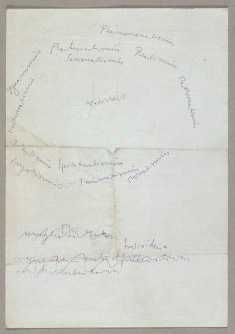
Fig.11
Joseph Beuys
Phänomenalismus 1974
Joseph Beuys Estate, Düsseldorf
© DACS 2019
In contrast to and in sharp distinction from reductionist positions, Beuys advocated a perspectivist understanding of truth, governed by individual experience and interpretation. He sketched this out in the drawing Phänomenalismus (Phenomenalism) 1974 (fig.11), where he grouped a number of ‘isms’ – including phenomenalism, realism, sensualism and spiritualism – around the central concept of ‘truth’. In Beuys’s understanding, all of these ways of thinking produce different perspectives on truth; such epistemological pluralism is obviously rooted in Nietzsche’s paradigmatic perspectivism.
In The Gay Science Nietzsche writes:
Fundamentally our actions are in an incomparable manner altogether personal, unique and absolutely individual there is no doubt about it; but as soon as we translate them into consciousness, they do not appear so any longer ... This is the proper phenomenalism and perspectivism as I understand it: the nature of animal consciousness involves the notion that the world of which we can become conscious is only a superficial and symbolic world, a generalised and vulgarised world; – that everything which becomes conscious becomes just thereby shallow, meagre, relatively stupid – a generalisation, a symbol, a characteristic of the herd; that with the evolving of consciousness there is always combined a great, radical perversion, falsification, superficialisation, and generalisation. Finally, the growing consciousness is a danger, and whoever lives among the most conscious Europeans knows even that it is a disease. As may be conjectured, it is not the antithesis of subject and object with which I am here concerned: I leave that distinction to the epistemologists who have remained entangled in the toils of grammar (popular metaphysics). It is still less the antithesis of ‘thing in itself’ and phenomenon, for we do not ‘know’ enough to be entitled even to make such a distinction. Indeed, we have not any organ at all for knowing, or for ‘truth’: we ‘know’ (or believe, or fancy) just as much as may be of use in the interest of the human herd, the species; and even what is here called ‘usefulness’ is ultimately only a belief, a fancy, and perhaps precisely the most fatal stupidity by which we shall one day be ruined.52
In contrast to this rather pessimistic way of discussing perspectivism, Joseph Beuys offered his own view:
That is the wonderful thing about our time, that this person has to see the world from a different angle, because he lives in the age of freedom, as I, and that this becomes complete when we put our points of view together and think about ourselves: ‘What's the next step?’.53
A final quote from Nietzsche’s Zarathustra may be helpful to summarise my argument:
And this most honest existence, the l – it speaks of the body and still wants the body, even when it poetises and raves and flutters with broken wings. Always more honestly learns it to speak, this I; and the more it learns, the more it finds titles and honours for the body and the earth. A new pride my I taught me and that I teach to men: no longer to thrust one’s head into the sand of heavenly things, but to carry it freely, a terrestrial head, which creates a meaning for the earth!54
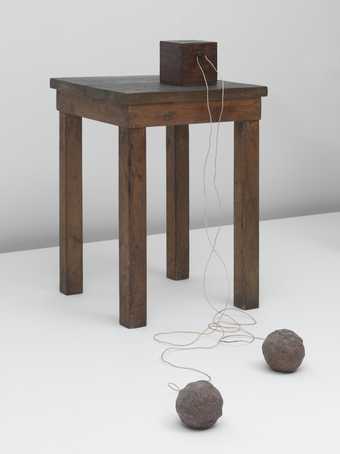
Fig.12
Joseph Beuys
Table with Accumulator 1958–85
Tate AR00603
© DACS 2019
Joseph Beuys tried precisely this: to give meaning to the earth and the body, sometimes close to the earth, sometimes close to the body, but staging their communication with each other. Works like Erdtelephon (Earth Telephone) 1973 or Table with Accumulator 1958–85 (fig.12) formulate the connection to the earth, which is the physical basis for collecting power from matter, with great precision. Table with Accumulator is an object and at the same time a geometric constellation, which juxtaposes the small, obviously hand-shaped clay globes with the formal rigour of the table and the accumulator – a type of battery. Once again, this composition by Beuys captures and embraces the whole of nature and the artificial world, joined in a striking, primordially simple system that shows how man and his production are inextricably connected to matter and natural forces.
